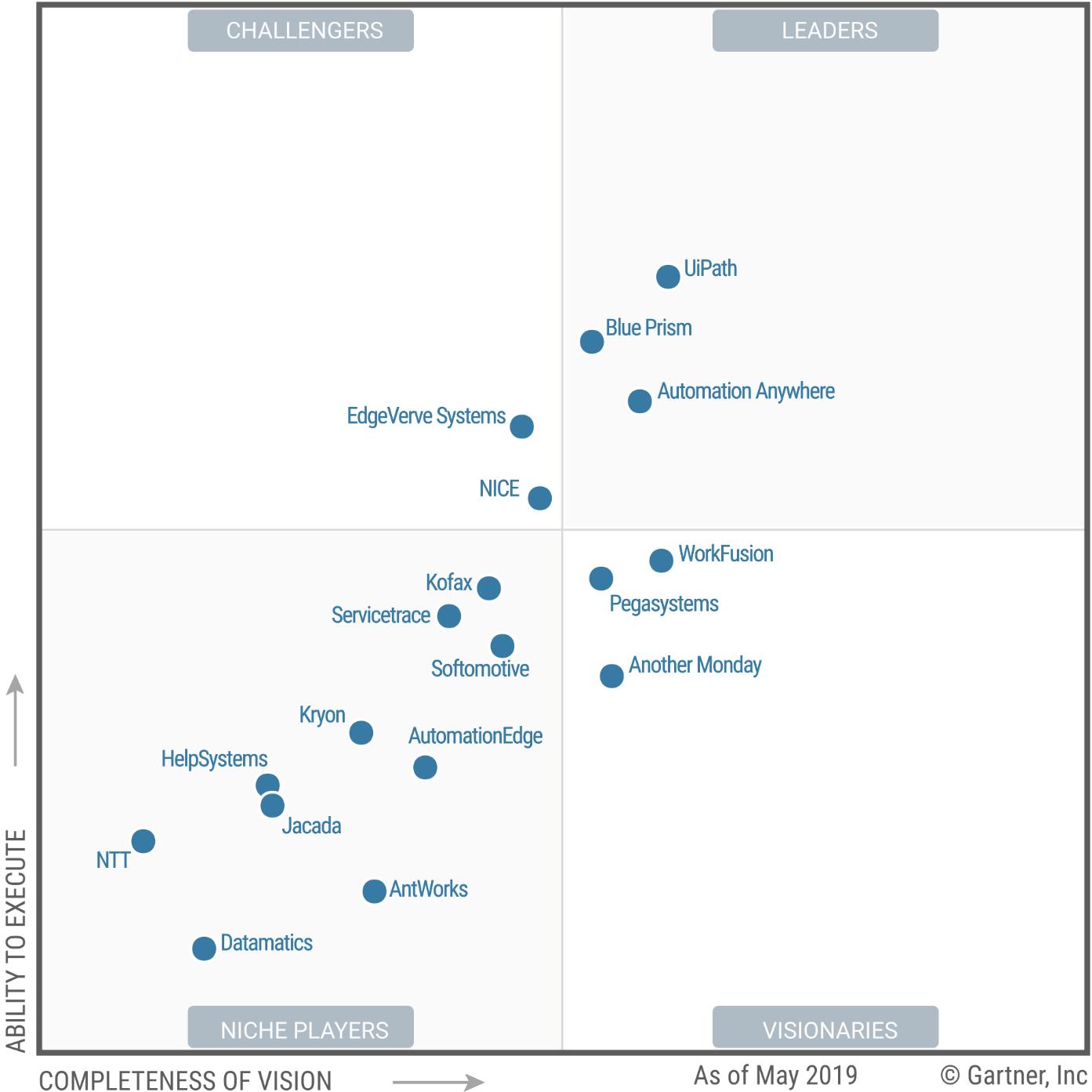Businesses are turning to Robotic Process Automation (RPA bots) to automate routine, rule-based tasks but what about perception-based tasks that often require human interaction? Robotic Process Automation (RPA) can be the answer but where does it fit in the long-term?
What is Robotic Process Automation (RPA)?
Robotic process automation or RPA is an automation approach and method that replicates human activity to reduce or eliminate the requirement of human intervention. RPA implementation is the most prevalent solution when tasks are mundane, repetitive or prone to human error.
RPA is growing exponentially: Forrester predicts the RPA industry will grow to $2.9 billion in 2021
In contrast to other automation solutions, RPA allows organisations to build automation into everyday tasks at a fraction of the cost and time compared to traditional methods. RPA is also non-intrusive in nature and utilises current corporate IT infrastructure without interruption to existing systems. Making RPA easy to implement even in a Proof of Concept (POC) or testing scenario.
Benefits of RPA
RPA directly improves multiple areas of impact, providing immediate quantifiable benefits such as dramatic error reduction and compliance and audit savings, facilitating digital transformation, enabling incremental revenue opportunities, and freeing resources to focus on process improvements and value-added work.
Bots are typically low-cost and easy to implement, requiring no custom software or deep systems integration.
- Reduce human error and increase compliance
- Integrate across platforms, RPA is platform agnostic
- Harness next-generation technology like Artificial Intelligence (AI), Cognitive Learning and Natural Language Processing (NLP)
- Free up expensive talent to concentrate on high-value tasks
Different types of RPA implementation
The first type is Attended Robots, where portions of the tasks are automated, and the control is returned to the user, the second is Unattended Robots, where the automation processes the job end-to-end and outputs the result without human intervention.
The RPA industry
As a market, RPA is still relatively small. Robotic process automation (RPA) software revenue grew 63.1% in 2018 to $846 million, making it the fastest-growing segment of the global enterprise software market, with RPA software revenue expected to reach $1.3 billion in 2019 according to Gartner.
RPA represents the convergence of multiple technologies within a consumer-friendly user interface. Advances in machine learning (ML) and artificial intelligence (AI) have enabled RPA to leap forward from its first emergence 20 years ago.
As many as a third of global enterprises are actively using bots within their IT and finance and accounting processes, with about a quarter adopting RPA within procurement and HR processes. [source]
RPA software leaders:
- UiPath: Headquartered in New York City, with approximately 1,900 employees distributed worldwide
- Blue Prism: Based in Warrington, U.K., with slightly fewer than 500 employees
- Automation Anywhere: Based in San Jose, California, with more than 1,200 employees
Effective robotic process automation implementations
Strategy first
As with any business decision, RPA also needs a strategy behind it in order for it to be successful. RPA can provide easy wins and can be easy to implement and test drive, so short and long-term strategy planning can be easily forgotten. Organisations must ensure RPA is incorporated into their business strategy and aligned to key elements including operations, IT and compliance.
RPA can be implemented into many aspects of an organisation. Therefore, it is very important for the organisation to understand what RPA is (and what it is not), its capabilities and dependencies.
Set and manage expectations
Understand where RPA has the most impact
Most businesses look at RPA as a means to improve tangible business challenges. While RPA can have an immediate and dramatic impact on Return on Investment, costs and productivity, it is often the intangible impacts that RPA directly affects. For example, staff morale improvements by eliminating monotonous/frustrating tasks or improving customer experience by implementing chatbots that answer customer service calls.
Involve IT early and every time
Almost all of the top RPA software vendors are targeting business users instead of the traditional IT buyer, the result is a demand to democratize process automation and data integration and make RPA available to the masses. While this sounds good in theory, it also creates issues at the implementation stage and in the future. Creating rogue bots that may not be aligned with the overall business strategy and sometimes completely disconnected from the rest of the business. It is because of these factors that business heads must involve IT from the outset to ensure they get the resources they require.
Keep track of automation and dependencies
We have talked about the benefits of RPA and the positive impact it can have on a business. It is also important to remember that RPA is a software that mimics human emulation based on scripts and learnings, RPA does not yet exhibit the intellect to interact as and adapt to all changes that affect robots. In the rush to get RPA deployed, some companies overlook the importance of communication between the various bots, which can break a business process. Implementors of RPA must plan every RPA robot build to keep track of and manage dependencies for each RPA robot.
Build an RPA Center of Excellence (CoE)
In order to have a successful RPA implementation, organisations must include a Centre of Excellence (CoE) in their implementation. A team with the knowledge and responsibility for providing best practice advice and sponsorship of RPA in an organisation.
A centre of excellence team develops:
- Business cases for changes and additions to an RPA robot fleet
- Calculates potential costs
- Builds risk/return metrics
- Is the liaison to external RPA experts
Test frequently
Remember that RPA has dependencies, while robots can run 24×7, it is important to routinely test robots to ensure they are still performing their task correctly and efficiently.
Great Minds RPA implementation approach
Great Minds can assist you across your entire RPA lifecycle including:
- Strategy
- Opportunity assessment
- Internal and external impact
- Revenue impact
- Risk mitigation
- Operational agility
- Deployment
- Governance
- Agile methodology
- Integration of business process, risk and CX
- RPA Centre of Excellence delivery
- Support and training



